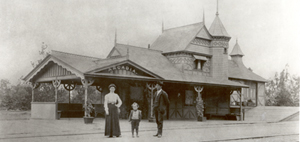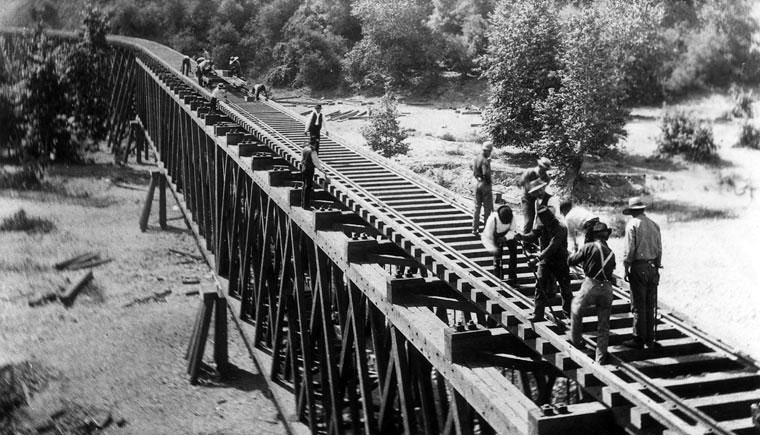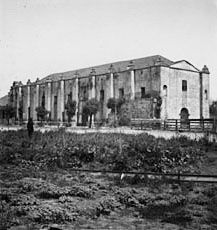|
Arcadia Station
Arcadia station is an at-grade light rail station on the A Line (Los Angeles Metro), A Line of the Los Angeles Metro Rail system. It is located at the intersection of 1st Avenue and Santa Clara Street in Arcadia, California, after which the station is named. This station opened on March 5, 2016, as part of Phase 2A of the Foothill Extension, Gold Line Foothill Extension Project. An overpass bridge was constructed over Santa Anita Avenue near the station. History Former bridge In Arcadia, a steel railroad bridge transitioned the Atchison, Topeka and Santa Fe Railway between the Interstate 210 and State Route 210 (California), I-210 and street grade. This bridge, between Baldwin and Santa Anita, was deemed unsafe following the 1994 Northridge earthquake and removed by Caltrans. The Phase 2A project constructed the "Iconic Freeway Structure or Gold Line Bridge" (IFS), as the replacement bridge. Designed by Minnesota artist Andrew Leicester, the bridge was unveiled in December ... [...More Info...] [...Related Items...] OR: [Wikipedia] [Google] [Baidu] |
Arcadia, California
Arcadia is a city in Los Angeles County, California, United States, located about northeast of downtown Los Angeles in the San Gabriel Valley and at the base of the San Gabriel Mountains. It contains a series of adjacent parks consisting of the Santa Anita Park racetrack, the Los Angeles County Arboretum and Botanic Garden, and Arcadia County Park. The city had a population of 56,681 at the 2020 United States census, 2020 census. The city is named after Arcadia (region), Arcadia, Greece. History Native American For over 8,000 years, the site of Arcadia was part of the homeland of the Tongva people ("Gabrieliño" tribe), a Indigenous peoples of California, Californian Native American tribe whose territory spanned the greater Los Angeles Basin, and the San Gabriel and San Fernando Valleys. Their fluid borders stretched between the Santa Susana Mountains, San Bernardino Mountains, and San Gabriel Mountains in the north; the Santa Monica Mountains and Simi Hills in the west; the ... [...More Info...] [...Related Items...] OR: [Wikipedia] [Google] [Baidu] |
Interstate 210 And State Route 210 (California)
The Foothill Freeway is a freeway in the Greater Los Angeles in the U.S. state of California, running from the Sylmar district of Los Angeles east to Redlands. The western segment is signed as Interstate 210 (I-210) from its western end at I-5 to SR 57 in Glendora, while the eastern segment is signed as State Route 210 (SR 210) to its eastern terminus at I-10. Under the California Streets and Highways Code, the entire Foothill Freeway is legally referred to as Route 210. The Foothill Freeway name is a reference to Foothill Boulevard and the San Gabriel Mountains, both of which the freeway runs parallel to for most of its length. The freeway follows the foothills of these mountains, connecting the northeastern suburbs of Los Angeles with the Inland Empire. Historically, the Foothill Freeway spanned multiple numerical designations. Additionally, the I-210 designation has changed routings, previously including a portion of what is now the Orange F ... [...More Info...] [...Related Items...] OR: [Wikipedia] [Google] [Baidu] |
Desert Wind
The ''Desert Wind'' was an Amtrak long-distance passenger train that ran from 1979 to 1997. It operated from Chicago to Los Angeles as a section of the ''California Zephyr'', serving Los Angeles via Salt Lake City; Ogden, Utah; and Las Vegas. History In the late 1960s, prior to the creation of Amtrak, the Union Pacific Railroad combined its long-distance streamliners between Chicago, Kansas City, and the West Coast into a single massive train dubbed by critics the "City of Everywhere". This train included the '' Challenger'', the '' City of Denver'', the '' City of Kansas City'', the '' City of Los Angeles'', the '' City of Portland'', and the '' City of San Francisco''. At one point, it ran up to 27 cars. The ''City of Los Angeles'' separated at Ogden, Utah, to serve Los Angeles via Las Vegas. Of these, Amtrak retained portions of the ''City of Kansas City'' and the ''City of San Francisco'' for its Chicago – San Francisco service, which it named the ''San Francisco Zeph ... [...More Info...] [...Related Items...] OR: [Wikipedia] [Google] [Baidu] |
Southwest Chief
The ''Southwest Chief'' (formerly the ''Southwest Limited'' and ''Super Chief'') is a Amtrak Long Distance, long-distance passenger train operated by Amtrak on a route between Chicago and Los Angeles through the Midwest and American Southwest, Southwest via Kansas City, Missouri, Kansas City, Albuquerque, New Mexico, Albuquerque, and Flagstaff, Arizona, Flagstaff mostly on the BNSF's Southern Transcon, but branches off between Albuquerque and Kansas City via the Topeka, La Junta Subdivision, La Junta, Raton Pass, Raton, and Glorieta Pass, Glorieta Subdivision. Amtrak bills the route as one of its most scenic, with views of the Painted Desert (Arizona), Painted Desert and the Red Cliffs of Sedona, Arizona, Sedona, as well as the plains of Illinois, Missouri, Kansas, and Colorado. During fiscal year 2023, the ''Southwest Chief'' carried 253,838 passengers, a 13.5% increase from FY2022. However, this is a 25% decrease from its pre-COVID-19 pandemic ridership of 338,180 passenger ... [...More Info...] [...Related Items...] OR: [Wikipedia] [Google] [Baidu] |
Amtrak
The National Railroad Passenger Corporation, Trade name, doing business as Amtrak (; ), is the national Passenger train, passenger railroad company of the United States. It operates intercity rail service in 46 of the 48 contiguous United States, contiguous U.S. states and three Provinces and territories of Canada, Canadian provinces. ''Amtrak'' is a portmanteau of the words ''America'' and ''track.'' Founded in 1971 as a Quasi-corporation, quasi-public corporation to operate many U.S. passenger rail routes, Amtrak receives a combination of state and federal subsidies but is managed as a for-profit corporation, for-profit organization. The company's headquarters is located one block west of Washington Union Station, Union Station in Washington, D.C. Amtrak is headed by a Board of Directors, two of whom are the United States Secretary of Transportation, secretary of transportation and chief executive officer (CEO) of Amtrak, while the other eight members are nominated to serve a ... [...More Info...] [...Related Items...] OR: [Wikipedia] [Google] [Baidu] |
Atchison, Topeka And Santa Fe Railroad
The Atchison, Topeka and Santa Fe Railway , often referred to as the Santa Fe or AT&SF, was one of the largest Class 1 railroads in the United States between 1859 and 1996. The Santa Fe was a pioneer in intermodal freight transport; at various times, it operated an airline, the short-lived Santa Fe Skyway, and the Santa Fe Railroad tugboats. Its bus line extended passenger transportation to areas not accessible by rail, and ferryboats on the San Francisco Bay allowed travelers to complete their westward journeys to the Pacific Ocean. The AT&SF was the subject of a popular song, Harry Warren and Johnny Mercer's " On the Atchison, Topeka and the Santa Fe", written for the film '' The Harvey Girls'' (1946). The railroad officially ceased independent operations on December 31, 1996, when it merged with the Burlington Northern Railroad to form the Burlington Northern and Santa Fe Railway. History Atchison, Topeka & Santa Fe Railway The railroad was chartered in February 185 ... [...More Info...] [...Related Items...] OR: [Wikipedia] [Google] [Baidu] |
Pasadena Subdivision
The Pasadena Subdivision is the remnant branch line of the former Atchison, Topeka and Santa Fe Railway (AT&SF) Los Angeles Second District. The line currently branches off of Metrolink’s San Bernardino Line at CP Cambridge in Claremont. The line follows a generally east–west alignment, passing through the cities of Claremont, Pomona, La Verne, San Dimas, Glendora, and Azusa before coming to a truncated end in Irwindale. For most of its length, it shares the corridor with the Los Angeles Metro Rail’s A Line. Recent construction, known as the Foothill Extension Phase 2B, has seen the tracks out of service west of San Dimas for most of 2021. History The line was initially built by the Los Angeles and San Gabriel Valley Railroad (LA&SGV) in 1885. LA&SGV was sold and consolidated on May 20, 1887, into the California Central Railway. In 1889 this was consolidated into Southern California Railway Company. On January 17, 1906, the Southern California Railway was sold to AT&SF ... [...More Info...] [...Related Items...] OR: [Wikipedia] [Google] [Baidu] |
Fairplex
The Fairplex has been the home of the L.A. County Fair since 1922. Known prior to 1984 as the Los Angeles County Fairgrounds, it is located in the city of Pomona, California. The L.A. County Fair is held during the month of May since 2022, but the facility is used year-round to host a variety of educational, commercial, and entertainment such as trade and consumer shows, conventions, and sporting events. The Fairplex is owned by Los Angeles County, but is leased to and is governed by an independent, self-supporting non-profit organization, the Los Angeles County Fair Association, which manages and produces the county fair and re-invests surplus revenues generated by the fair and other events in the maintenance and development of the facility. Facilities Having begun in 1922 with donated by the City of Pomona, the Fairplex grounds now cover and include nearly of indoor exhibit space. Slightly less than half of the grounds are given over to paved parking areas to accommodate ... [...More Info...] [...Related Items...] OR: [Wikipedia] [Google] [Baidu] |
Los Angeles And San Gabriel Valley Railroad
The Los Angeles and San Gabriel Valley Railroad was a railroad founded on September 5, 1883, by James F. Crank with the goal of bringing a rail line to Pasadena, California from downtown Los Angeles, the line opened in 1886. Los Angeles and San Gabriel Valley Railroad was sold and consolidated on May 20, 1887 into the California Central Railway. In 1889 this was consolidated into Southern California Railway Company. On Jan. 17, 1906 Southern California Railway was sold to the Atchison, Topeka and Santa Fe Railway and called the Pasadena Subdivision. The main line closed in 1994. The railroad later reopened as the MTA Gold Line Light Rail service in July 2003. History James F. Crank founded the Los Angeles and San Gabriel Valley Railroad on Sept. 5, 1883 with the goal of bringing a rail line to Pasadena from downtown Los Angeles. Los Angeles and San Gabriel Valley Railroad sold stock to get funds to build the new rail line, Lucky Baldwin purchased a large share of stock ... [...More Info...] [...Related Items...] OR: [Wikipedia] [Google] [Baidu] |
Western Diamondback Rattlesnake
The western diamondback rattlesnake or Texas diamond-backWright AH, Wright AA. (1957). ''Handbook of Snakes''. Comstock Publishing Associates. (7th printing, 1985). . (''Crotalus atrox'') is a rattlesnake species and member of the viper family, found in the southwestern United States and Mexico. Like all other rattlesnakes and all other vipers, it is venomous. It is likely responsible for the majority of snakebite fatalities in northern Mexico and the greatest number of snakebites in the U.S.Norris R. (2004) "Venom Poisoning in North American Reptiles" in Campbell JA, Lamar WW. ''The Venomous Reptiles of the Western Hemisphere''. Comstock Publishing Associates, Ithaca and London. . No subspecies are currently recognized. It lives in elevations from below sea level up to . This species ranges throughout the Southwestern United States and northern half of Mexico. Currently, western diamondback rattlesnakes are not threatened or endangered. Common names Other common names for this ... [...More Info...] [...Related Items...] OR: [Wikipedia] [Google] [Baidu] |
San Gabriel Valley
The San Gabriel Valley (), sometimes referred to by its initials as SGV, is one of the principal valleys of Southern California, with the city of Los Angeles directly bordering it to the west and occupying the vast majority of the southeastern part of Los Angeles County. Surrounding landforms and other features include: * the San Gabriel Mountains to the north; * the San Rafael Hills to the west, with the Los Angeles Basin beyond; * the Crescenta Valley to the northwest; * the Puente Hills to the south, with the coastal plain of Orange County, California, Orange County beyond; * the Chino Hills and San Jose Hills to the east, with the Pomona Valley and Inland Empire (CA), Inland Empire beyond; and * the city limits of Los Angeles bordering its western edge. The San Gabriel Valley derives its name from the San Gabriel River (California), San Gabriel River that flows southward through the center of the valley, which itself was named for the Spanish Mission San Gabriel Arcángel ... [...More Info...] [...Related Items...] OR: [Wikipedia] [Google] [Baidu] |





